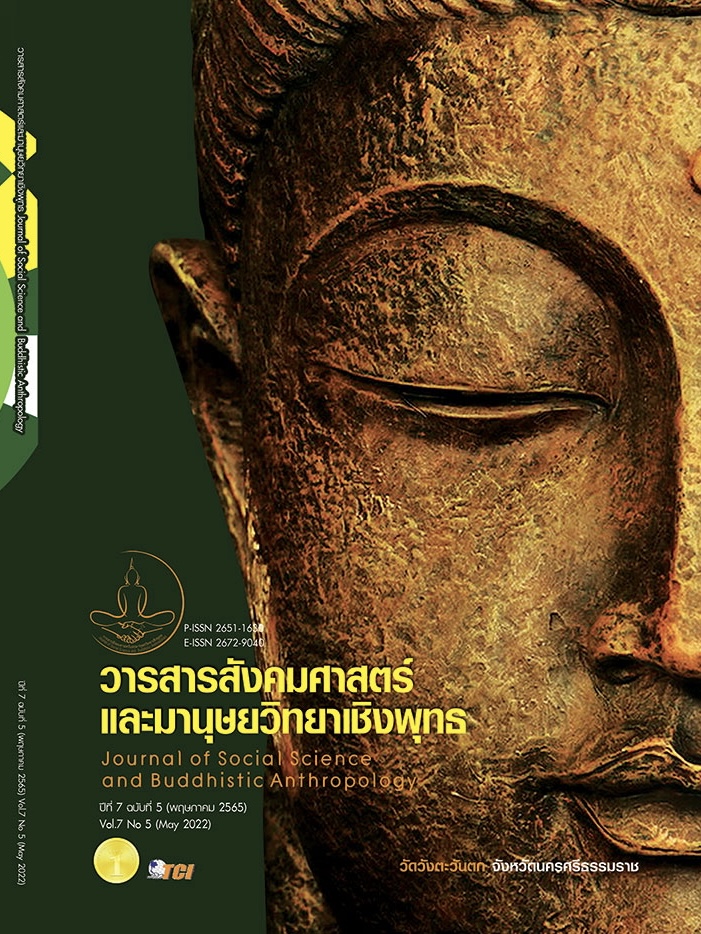CASUAL FACTORS INFLUENCING COMPETITIVE ADVANTAGE AND PERFORMANCE OF TENNIS TRAINING CENTER BUSINESS IN THAILAND
Keywords:
Competency, Innovation, Marketing Orientation, Competitive Advantage, PerformanceAbstract
The objectives of this research article were to : 1) investigate the factors that influence competitive advantage and performance in the tennis training center business in Thailand. 2) investigate the direct and indirect effects of factors influencing the competitive advantage and performance of the Tennis Training Center Business in Thailand. 3) develop a model for gaining a competitive advantage and improving the performance of the Tennis Training Center Business in Thailand. This study employed both quantitative and qualitative research methods. Questionnaires were used to collect data from customers of Thailand's tennis training center business. A total of 400 samples were sampled at random using a specific method. In-depth interviews were conducted with 7 experts from the tennis training center business, including executives, academics, and customers, to confirm the study's findings. The data was examined using the structural equation model. According to the study's findings, all factors were linked, both directly and indirectly. 1) Competency, innovation, and market orientation have a positive impact on competitive advantage and performance. 2) The following are the weights of the majority of the components in each factor: 2.1) Competency is defined as skills. 2.2) Process innovation is an example of innovation. 2.3) Interfunctional coordination is required for market orientation. 2.4) Differentiation and quick response provide a competitive advantage. 2.5) From a financial standpoint, performance is important. 3) The concordance index of the hypothesis model was discovered using confirmatory component analysis with the structural equation model. Index value X2 /df = 1.48, p-value = 0.158 passed the acceptance criteria, CFI = 0.999, GFI = 0.995, AGFI = 0.927. The structural equation modeling model was determined to be appropriate. Compliant with empirical data and considered new knowledge.
References
กรมพัฒนาธุรกิจการค้า. (2561). สถิติรายได้อุตสาหกรรมการกีฬา. เรียกใช้เมื่อ 15 สิงหาคม 2561 จาก http://sports.mots.go.th/sport63/sports_business.php
กระทรวงการท่องเที่ยวและกีฬา. (2560). แผนพัฒนาการกีฬาแห่งชาติ ฉบับที่ 6 (พ.ศ. 2560 - 2564). เรียกใช้เมื่อ 18 เมษายน 2560 จาก https://www.mots.go.th/ ewt_dl_link.php?nid=8408
ก้องภพ เลิศชัย. (2564). ปัจจัยเชิงสาเหตุที่มีอิทธิพลต่อการสร้างความได้เปรียบในการแข่งขันและผลการดำเนินงานของธุรกิจศูนย์ฝึกกีฬาเทนนิสในประเทศไทย. ใน ดุษฎีนิพนธ์ บริหารธุรกิจดุษฎีบัณฑิต สาขาวิชาการบริหารการจัดการ. มหาวิทยาลัยศรีปทุม.
กัลยา วานิชย์บัญชา. (2549). สถิติสำหรับงานวิจัย. กรุงเทพมหานคร: จุฬาลงกรณ์มหาวิทยาลัย.
ขนิษฐา ศรีตะวัน. (2564). ปัจจัยเชิงสาเหตุที่มีอิทธิพลต่อการสร้างความได้เปรียบในการ แข่งขันและผลการดำเนินงานของธุรกิจศูนย์ฝึกกีฬาเทนนิส ในประเทศไทย. ใน ดุษฎีนิพนธ์บริหารธุรกิจดุษฎีบัณฑิต สาขาวิชาการบริหารการจัดการ. มหาวิทยาลัยศรีปทุม.
ทวี ฉิมอ้อย. (2564). ปัจจัยเชิงสาเหตุที่มีอิทธิพลต่อการสร้างความได้เปรียบในการแข่งขันและ ผลการดำเนินงานของธุรกิจศูนย์ฝึกกีฬาเทนนิส ในประเทศไทย. ใน ดุษฎีนิพนธ์ บริหารธุรกิจดุษฎีบัณฑิต สาขาวิชาการบริหารการจัดการ. มหาวิทยาลัยศรีปทุม.
ธนากร ศรีชาพันธุ์. (2564). ปัจจัยเชิงสาเหตุที่มีอิทธิพลต่อการสร้างความได้เปรียบในการ แข่งขันและผลการดำเนินงานของธุรกิจศูนย์ฝึกกีฬาเทนนิส ในประเทศไทย. ใน ดุษฎีนิพนธ์บริหารธุรกิจดุษฎีบัณฑิต สาขาวิชาการบริหารการจัดการ. มหาวิทยาลัยศรีปทุม.
พงศ์พันธุ์ ฉิมดี. (2564). ปัจจัยเชิงสาเหตุที่มีอิทธิพลต่อการสร้างความได้เปรียบในการแข่งขันและผลการดำเนินงานของธุรกิจศูนย์ฝึกกีฬาเทนนิส ในประเทศไทย. ใน ดุษฎีนิพนธ์ บริหารธุรกิจดุษฎีบัณฑิต สาขาวิชาการบริหารการจัดการ. มหาวิทยาลัยศรีปทุม.
ศูนย์วิจัยกสิกรไทย. (2563). ออกกำลังกายฮิตปลุกกระแสธุรกิจรักสุขภาพ. เรียกใช้เมื่อ 5 กุมภาพันธ์ 2563 จาก https://kasikornresearch.com/SiteCollectionDocuments/ analysis/k-social-media/sme/fitnessBT/Fitness_BT2020
สุพิตร สมาหิโต. (2547). แนวทางการพัฒนานักกีฬาภายใต้การสนับสนุนและส่งเสริมของภาครัฐและภาคเอกชนอย่างเป็นระบบ กรณีศึกษากีฬาเทนนิสอาชีพและกีฬาฟุตบอลอาชีพ. กรุงเทพมหานคร: สำนักงานเลขาธิการวุฒิสภา.
อรนุช กล่อมดี. (2550). กระบวนการสร้างกระแสนิยมในการเล่นกีฬาเทนนิสอาชีพของสื่อหนังสือพิมพ์ในปี 2546 กรณีศึกษาวาทกรรมภราดรฟีเวอร์. ใน วิทยานิพนธ์นิเทศศาสตรมหาบัณฑิต สาขาวิชานิเทศศาสตร์. มหาวิทยาลัยกรุงเทพ.
โอม โตอาจ. (2564). ปัจจัยเชิงสาเหตุที่มีอิทธิพลต่อการสร้างความได้เปรียบในการแข่งขันและ ผลการดำเนินงานของธุรกิจศูนย์ฝึกกีฬาเทนนิส ในประเทศไทย. ใน ดุษฎีนิพนธ์ บริหารธุรกิจดุษฎีบัณฑิต สาขาวิชาการบริหารการจัดการ. มหาวิทยาลัยศรีปทุม.
โอรัส เทวกุล. (2564). ปัจจัยเชิงสาเหตุที่มีอิทธิพลต่อการสร้างความได้เปรียบในการแข่งขันและผลการดำเนินงานของธุรกิจศูนย์ฝึกกีฬาเทนนิส ในประเทศไทย. ใน ดุษฎีนิพนธ์ บริหารธุรกิจดุษฎีบัณฑิต สาขาวิชาการบริหารการจัดการ. มหาวิทยาลัยศรีปทุม.
Alshammari, A. M. (2012). The Evaluation of the Impact of using Balanced Scorecard on Strategic Performance in Small and Medium Enterprises. Galway-mayo Institute of Technology, 17(1), 100-104.
Amniattalab, A. & Ansari, R. (2016). The effect of strategic foresight on competitive advantage with the mediating role of organisational ambidexterity. International Journal of Innovation Management, 20(1), 1-18.
Ar, I. M. & Birdogan, B. (2011). Antecedents and performance impacts of product versus process innovation. European Journal of Innovation Management, 14(2), 172-206.
Baker, G. R., et al. (2008). High Performing Healthcare Systems: Delivering Quality by Design. Toronto: Longwoods Publishing.
Filatotchev, I. & Nakajima, C. (2014). Corporate governance, responsible managerial behavior, and corporate social responsibility: Organizational efficiency versus organizational legitimacy. Academy of Management Perspectives, 28(3), 289- 306.
Healy, P. et al. (2014). Market competition, earnings management and persistence in accounting profitability around the world. Review of Accounting Studies, 19(4), 1281-1308.
HR Washington State Human Resources. (2012). Competencies. Retrieved September 15, 2019, from http://www.hr.wa.gov/pages/default.aspx
Juan, J. L. & Zhou, K. Z. (2010). How foreign firms achieve competitive advantage in the Chinese emerging economy: managerial ties and market orientation. Journal of Business Research, 63(8), 856-862.
Kearney, A. T. (2014). Winning in the business of sports. Retrieved September 5, 2019, from https://www.kearney.com/communications-media-technology/article? /a/winning-in-the-business-of-sports
Marsh, H. W. & Hocevar, D. (1985). Application of Confirmatory Factor Analysis to The Study of Self-concept: First and Higher-order Factor Models and Their Invariance Across Groups. Psychological Bulletin, 97(3), 562-582.
Noor, H. A. et al. (2010). Is Entrepreneurial Competency the Silver Bullet for SME Success in a Developing Nation. International Business Management, 4(2), 67-75.
Pitts, B. G. & Stotlar, D. K. (1996). Fundamentals of sport marketing. Morgantown, WV: Fitness Information Technology.
Schwabe, G. & Prestipino, M. (2005). How Tourism Communities Can Change Travel Information Quality. Retrieved August 30, 2019, from https://aisel.aisnet.org /ecis2005/111
Sigala, M. (2009). E-service quality and Web 2.0: expanding quality models to includecustomer participation and inter-customer support. The Service Industries Journal, 2009(1), 1–18.
Sukglun, A., et al. (2018). Strategies for Creating Competitive Advantage for Smart Farming Enterprise. Executive Journal, 38(1), 91-100.
Sutapa. S. et al. (2017). The Role of Market Orientation, Creativity and Innovation in Creating Competitive Advantages and Creative Industry Performance. Jurnal Dinamika Manajemen, 8(2), 152-166.
Downloads
Published
How to Cite
Issue
Section
License
Copyright (c) 2022 Journal of Social Science and Buddhistic Anthropology

This work is licensed under a Creative Commons Attribution-NonCommercial-NoDerivatives 4.0 International License.








